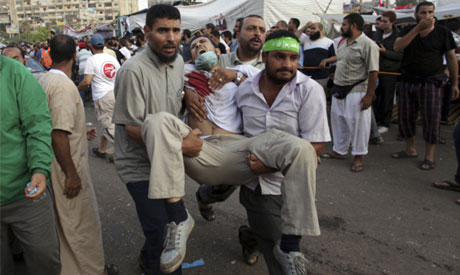Egypt's Bloody Turmoil
Seeking the legitimacy of wide public approval, Egypt's army chief Abdel Fattah El-Sisi declared he was prepared to act on the peoples' wishes. He sought a "mandate to deal with violence and potential terrorism", caused by the incitement to defy the authority vested in him by popular appeal as head of the Supreme Council of the Armed Forces of Egypt, by the Muslim Brotherhood. Mohammed Morsi, after removal from power as president of the country has now been charged with criminal offences.Offences relating to his having conspired with Hamas to launch a prison break from a prison in Cairo's northern region to release himself and dozens of other high-ranking Muslim Brotherhood officials from imprisonment. During the break-out fourteen prison guards were killed. It seems reasonable that a judicial investigation leading to a trial take place. Of course, it is questionable to begin with if this was known before the Muslim Brotherhood offered Mr. Morsi up as their presidential candidate a year ago, why he wasn't charged then.
Perhaps the answer lies in the fact that there was chaos, that there were hopes that matters could be settled, that all factions in the country could be accommodated through the advent and the results of a fair and democratic federal election. Bypassing the reality that the Muslim Brotherhood represented the only political group that had long succeeded in regulating itself, in forming a well designed political structure prepared to launch an election campaign.
Unlike the other groups whose appearance on the scene was relatively new and relatively by chance, with little organizing experience leaving them incapable of launching a meaningful campaign where those groups who had much in common socially and ideologically could merge and support one another to achieve a much greater success than they were able to mount, leaving them outside the levers of government, even though their actions had led to the downfall of the Hosni Mubarak autocracy.
With General Sisi's invitation to Egyptians to appear in force of numbers to validate his actions, came a matching declaration of the Muslim Brotherhood, exhorting their members to match the numbers of the anti-Morsi campaigners. And this is what set the stage for the pandemonium that followed, those who died on Saturday, and the hundreds who were wounded. The military did fire on protesters, and they did so primarily in an effort to disperse them, and to halt the chaos that saw the two sides converging in a multi-pronged attack on one another.
It would be expected that the military has arms and they will use them if and when deemed necessary. And it is deemed necessary when, from among the crowds that oppose their dismantling of the government that the Muslim Brotherhood assembled and the removal of Mohammed Morsi, weapons have been used to fire at the military, provoking deadly confrontations. According to doctors stationed at the field hospital of the pro-Morsi group in Nasr City, 200 protesters were killed, 4,500 injured; shot, they claimed.
The Ministry of Health disputes the figures, claiming 80 people to have been shot dead early Saturday. Forensic specialists have been charged by the prosecution to determine the cause of those deaths. Eyewitness accounts claim that Morsi supporters rallied atop the Sixth of October Bridge, blocking it, causing action from security forces. Nasr Street leading to the bridge was blocked, and Morsi supporters attempted to torch the Egypt Expo & Convention Authority.
Police have arrested 74 people suspected of having spurred the violence. They seized firearms, ammunition and knives. Massive sit-ins have been staged for the past several weeks near the Rabaa Al-Adawyia Mosque, along with sit-ins at Al-Nahda Square across from Cairo University, as well as organized marches across Egypt, demanding Morsi's reinstatement as president of the country. On Friday, encouraged to increase their numbers after morning prayers, more protesters appeared near the Sixth of October Bridge.

Supporters
of Egypt's ousted President Mohammed Morsi carry an injured man to a
field hospital following clashes with security forces at Nasr City,
where pro-Morsi protesters have held a weeks-long sit-in, in Cairo,
Egypt, Saturday, July 27, 2013 (Photo: AP)
The Tamarod youth Rebel movement, recognized as the driving force behind the June 30 protests resulting in the removal of Mohammed Morsi through its co-founder Mahmoud Badr has proposed inspections by prosecutors, rights campaigners and Arab League members at the protest camps to remove any weapons they may discover there. He recommends that the delegates be given powers of arrest in the event of arms being found, or the identity of suspects causing violence are revealed.
This type of initiative, he contends, should be designed and practised as a way in which the country could move forward toward "rejecting the arming of [protest] squares and restoring the value of peaceful sit-ins".
Labels: Conflict, Egypt, Muslim Brotherhood

<< Home